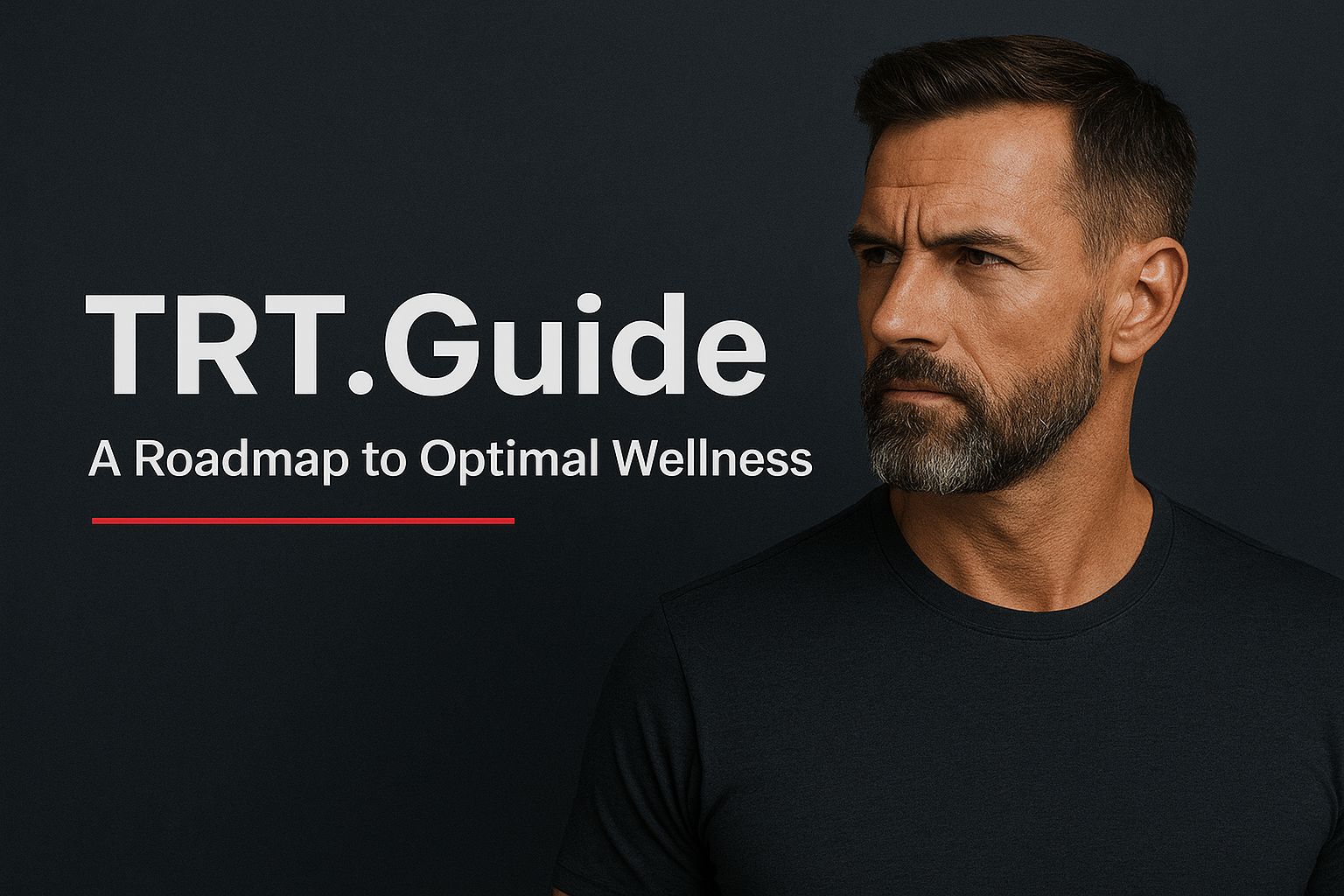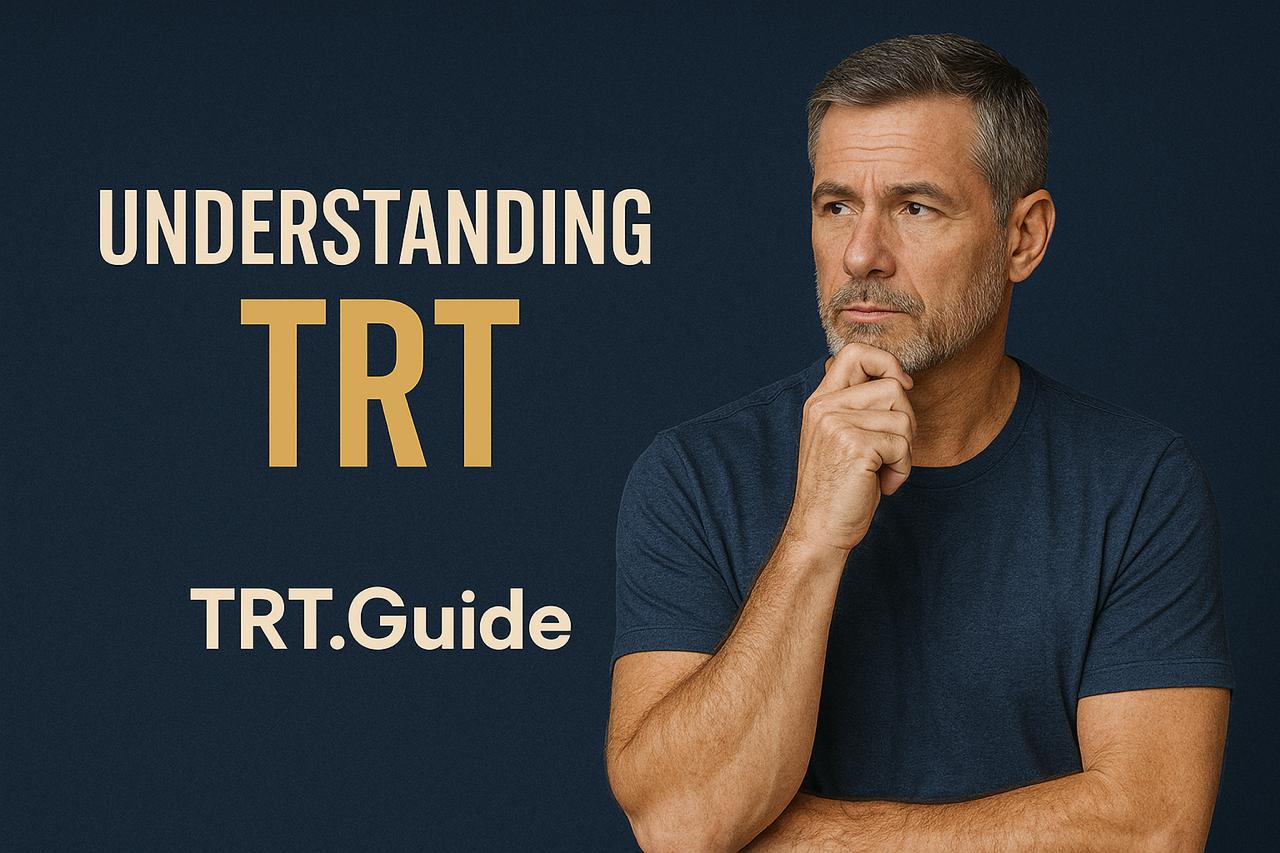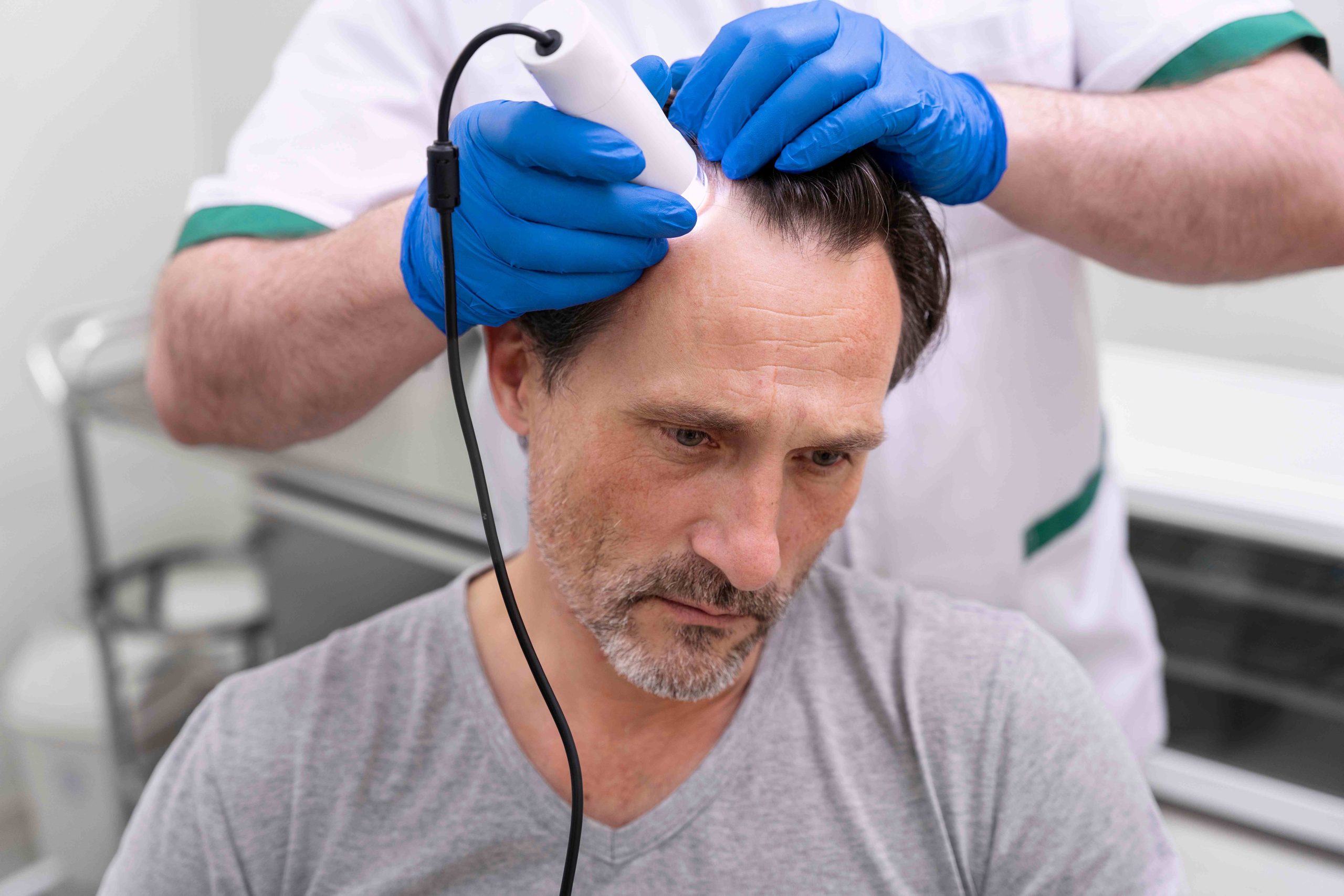If you’re suffering from hair loss, you might be wondering whether there is a relation between testosterone replacement therapy (TRT) and hair thinning. Most guys take a testosterone replacement therapy (TRT) to fight off the situations of low hormone levels, therefore, be more active and healthy. The truth of the matter is that hair loss and testosterone are closely related, and the way they interact is often misunderstood.
Of the various advantages that the TRT procedure has to offer, it can still potentially be one of the factors that can promote hair loss in both the sexes. Before making the decision to use TRT, it is important that you understand the relationship between hair follicles and testosterone. Therefore, in this article, we’ll be discussing the side effects of TRT on the hair and how you can use this information to choose the best hair treatment for you.
Overview of Testosterone Replacement Therapy
TRT is a treatment that brings hormonal balance to men with low testosterone levels. In many cases, the latter heals the mood, improves physical condition and can also have side effects on hair.
What Is Testosterone Replacement Therapy?
TRT stands for testosterone replacement therapy (TRT) and it is conveyed as the administration of testosterone to men with low testosterone levels. The modern means of treatment such as injections, patches, and gels have been the most commonly used methods. The causes of low testosterone, also called hypogonadism, are many: aging, health conditions, and some drugs.
The goal of the therapy is to lessen fatigue, depression, and decrease the feeling of libidinal energy by simply increasing the concentration of hormones in the body. For the patient often, medical professionals are from time to time performing assessments and hormonal tests with a view of providing the patient with a proper and accurate diagnosis.
Benefits of Testosterone Replacement Therapy
Testosterone replacement therapy provides numerous benefits, as a result, improving the overall quality of life.
- Increased Energy: TRT positively affects energy levels, lessening tiredness, and the feeling of being weak.
- Improved Mood: Most of the patients have reported much better mood, and the number of cases of depression has been shown to decline substantially.
- Enhanced Libido: The chances are that higher testosterone levels will lead to an increased level of sexual desire and a stronger person in terms of both male and female sexual appeal.
- Increased Muscle Mass: Along with the ability of TRT to give a hand in the growth of the muscle, it can also be the vessel for strength, thus helping the people engaged in weight training.
- Better Cognitive Function: Surprisingly, numerous studies indicate the significant positive effects of balanced testosterone levels on memory improvement and concentration enhancement.
Each benefit outlined above is a keyhole to the real potential that TRT could register in the physical and emotional health of a person. However, it’s always essential to consult a physician, discuss your health requirements to figure out the procedure’s potential risks and benefits.
The Link Between Testosterone and Hair Loss
Testosterone has a major role in hair growth and its health, and comprehending the functions will help you understand the impact of testosterone replacement therapy (TRT) on your hair.
How Testosterone Affects Hair Growth
The most direct effect of testosterone on hair growth is by its conversion into dihydrotestosterone (DHT). DHT works as a stimulator in hair follicles as it sticks to the androgen receptors in hair, doing the job of resuscitating hair growth in those areas where it had been lost to other conditions. On the contrary, it can also cause a lot of hair loss on the scalp. A further increase of DHT may contribute to hair follicle miniaturization, which can initiate the process of the hair shaft becoming thinner and shorter and finally leading to baldness.
The results of the research have shown that DHT might be more active in the hair follicles of balding individuals (men or women). This condition can be related to the genetic factors that are responsible for the hair condition of hair thinning.
Moreover, the levels of DHT in the body can be changed by taking testosterone, which in turn can affect the hair growth pattern. It is important to control these levels during TRT to keep hair healthy.
Types of Testosterone-Related Hair Loss
Androgenetic alopecia is a condition that is most often caused by testosterone and accounts for 98% of all hair loss cases. This disease is characterized by the loss of hair all over the scalp in both genders, and it is hereditary. The male baldness pattern is usually stated as a backward hairline and the thinning area on the crown, while the female way is the wispy hair on the whole head.
When undergoing TRT, there is a possibility of telogen effluvium due to the up and down fluctuations of testosterone levels. This affliction is characterized by temporary hair fall which is triggered by a variety of stressors or hormonal changes and is mostly reversible, yet it may result in the apparent thinning of the hair.
Also, it is important to note that there is a small part of the population that can go through alopecia areata, a hereditary disease linked to hormonal changes, like TRT. In this case, hair loss occurs in patches all of a sudden, and each reaction will be different from others.
Testosterone Replacement Therapy and Hair Loss
Testosterone is the primary male sex hormone and is responsible for the vast array of male sexual characteristics. The testosterone hormone has a significant impact on the health of your hair besides being the main regulator of male growth and development. Educating yourself about the finer details of TRT can help you to make a well-grounded decision regarding the treatment of your situation.
Is Testosterone Replacement Therapy the Cause of Hair Loss?
Testosterone supplementation is one of the sources of hair loss in some men. High levels of testosterone may trigger the increased production of DHT, which is a potent hormone associated with hair shedding. Nonetheless, the aforementioned male research on TRT and hair loss claims that the treatment did not hinder hair growth in the vast majority of subjects. The fact is that the DHT is the issue instead of the testosterone hormone which is responsible for promoting hair growth in certain areas.
Testosterone and Hair Loss: The Study Results
A large number of investigations confirm the relationship between male hormone levels and baldness. A study at one notch up to this about male hormone baldness showed that men who received TRT got an increase in DHT levels that consequently made them lose their hair mostly if they had a long-term history of being sensitive to it. It was also detailed that hair thinning in TRT could be accelerated if individuals predisposed to baldness were involved while the density in terms of hair growth might have a lost relation…
Alternative Treatments for Hair Loss
Besides TRT, there are still several other ways to deal with hair loss. These steps comprise not only medicines but also changes in lifestyle.
Non-Hormonal Options
Medicines, not related to hormones, may be borrowed as a remedy for hair loss. Using Minoxidil, which is applied topically, directly stimulates hair growth and turns back the process of hair losing thinning. Swallowing Finasteride works by blocking the way DHT is generated from testosterone and thus prevents hair loss in men.
By the use of Low-level laser therapy, hair follicle health can be enlarged and the growth of hair can be evoked with the help of some specific wavelengths of light. Hair transplant operations, through decentralizing the hair follicles from those areas with much hair, can give a long-term continuous outcome. Well-balanced dietary supplements, touching biotin, zinc, and saw palmetto, are also good for hair health. These options might be used together with TRT or as standalone treatments.
Lifestyle Changes for Hair Loss Prevention
Adhering to some lifestyle adjustments really helps to reduce the chances of hair loss. Good nutrition, i.e., consuming foods high in proteins, vitamins, and minerals, plays a critical role in the grooming of hair follicles. Suggestions include eggs, fish, nuts, and leafy greens. Also, regular physical activity is very important as it fosters blood flow to the scalp, a better distribution of nutrients. Apart from that, stress control techniques such as mindfulness and yoga could suppress the excessive production of cortisol, which is not beneficial to hair growth.
Hairstyles which are worn too tight can pull on hair, cause traction alopecia, and thus must be avoided. Another tip is that the application of hair-styling tools using heat, and being within limits of the use of harsh chemical treatments could pose less or almost no risk of hair damage. To sum up, sound sleep makes a significant contribution to the general health and possibly to hair growth. The introduction of these changes will create a stronger position for your hair to develop further.
Future Considerations and Research
Studies still need to be conducted in order to understand it further and to see if testosterone replacement therapy has any impact on hair loss. The studies that are coming out are geared at figuring out whether the relationship between male hormones and hair health is simple or complex.
Theoretical Studies Centered on Testosterone and Hair Health
You may become aware of theoretical studies that scrutinize dissimilar testosterone formulations in terms of hair growth and hair loss. Some research maintains that differences in TRT modalities, such as injections, gels, or patches, might bring about diverse effects on hair health. For instance, one study shows that some types of used testosterone would certainly lead to less testosterone conversion to dihydrotestosterone, thus decreasing the risk of hair loss.
Ongoing studies also address the presence of genes, regulating responses to TRT, which would make the treatment more personalized. The assessment of androgen receptor sensitivity and the determination of genetic predisposition enhances the option of therapy that is more focused. Such choices could be the grounding for making personalized strategies that will make a treatment more efficient and help avoid hair health-impacting side effects, at the same time.
New Trends in Treatment
Upcoming are the trends in treatment that bring solutions to TRT-induced hair loss and leave the therapy’s safety unaffected. The SARMs, that is, selective androgen receptor modulators are being trialed for their viability as a source of testosterone effects without detrimental effects such as losing hair. The marriage of the old line up with the new ones is also a way to go.
Therefore, by marrying conventional practice with other growth stimulating measures, hair growth will not only be guaranteed, but also, low testosterone will be resolved. Another aspect of hair care that is also increasingly being addressed is the use of dietary supplements and lifestyle changes that help the affinity of the hair to the body. This wave of embracing other methods and ways of eating has led to a re-evaluation of the multifaceted approach concept, which in itself has shown a possibility of not only averting the problem but also gain adequate symptom control.
Conclusion
Dealing with the matter of testosterone replacement therapy, based on the aspect of hair loss, is a tricky thing. It is of utmost importance to weigh the pluses and deficits of TRT as it medically affects your hair. You should be well informed, do some DHT level checks, and you will take part in the decision-making process, not only for the best but even in getting the proper treatment results.
It might be helpful to talk about other methods of treatment and behavior changes that can aid hair renewal beside TRT. Such a sort of lifestyle that is not reliant on one method not only enhances the individual’s general health status but also, and more importantly, keeps his or her hair healthy. This kind of personalized program is definitely the catchword to reach your maximum health and hair aspirations in the process.
Frequent Ask Questions
What is testosterone replacement therapy (TRT)?
TRT is the administration of a male patient pumping in his organism the testosterone he evidently lacks. It is done by doctors since they know specific details and use tools to send the hormone in the man. TRT can be carried out with the help of different methods such as injections, patches, and gels.
How does testosterone affect hair loss?
Testosterone has an influence on hair growth as it turns into dihydrotestosterone (DHT). Even though DHT has the potential to promote hair growth in some parts, it can hinder hair growth on the human scalp, particularly in people who are liable to the hormone.
Can TRT cause hair loss?
Yes, it is possible that TRT may induce hair loss on account of heightened DHT levels. People with the gene for androgenetic alopecia who use TRT face the risk of their disease worsening, as the DHT triggered by therapy can damage hair follicles.
How should I track my hair health while undergoing TRT?
It is important to monitor the levels of DHT during TRT so that treating hair health is possible. The best thing to do first is to consult a healthcare provider to carry out an evaluation and prescribe the proper therapy, among other things, reduce the risks of hair loss.
Which changes in the way of life can provide support for hair health?
Hair health is possible by following a diet regimen, regular exercise, stress control, and not following hair practices that are harmful. These changes can make TRT more effective or can be a way of solving the problem.
What might be some possible directions for the development of TRT and hair loss?
New ideas, e.g., the use of different testosterone formulations for hair regrowth, are being researched. Certain types of hair transplants, for example, platelet-rich plasma injections, can lower the risk of baldness by making TRT safe in terms of hair loss.






